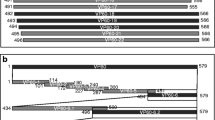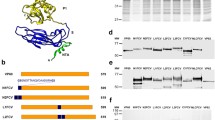Abstract
During infection host histo-blood group antigens (HBGAs) act as attachment factors that interact with rabbit hemorrhagic disease virus (RHDV) and participate in the infectious process. In the present study, baculovirus expressing recombinant RHDV capsid protein (VP60r) as a vaccine immunogen was used to test its antigenicity and immunogenicity via immunization experiments. Each group of rabbits immunized with VP60r was found to be fully protected against RHDV challenge. The duration of immunity of the vaccine following the inoculation of a single dose was determined to be at least 240 days. RHDV-specific humoral responses in antisera from inoculated rabbits were analyzed using VP60r virus-like particle (VLP)-based ELISA. Anti-VP60-specific antibody was produced by 7 days post-primary immunization. Following this stage, the levels of this antibody increased steadily, peaking at 90 days and maintaining a high level until 240 days. We developed a synthetic carbohydrate assay to detect blockage in attachment of RHDV VLPs to HBGAs by the rabbit antisera. On day 7 post-immunization, serum samples were demonstrated to block the binding of H type 2 to RHDV VLPs, with a blocking rate of almost 60%, a value that then increased steadily over time. From day 60 to day 240 post-immunization, serum samples completely blocked the binding of H type 2 to RHDV VLPs, with a blocking rate of almost 100%. This indicated that VP60-induced antibodies neutralize the interaction of RHDV with HBGAs.





Similar content being viewed by others
References
Abrantes J, van der Loo W, Le Pendu J, Esteves PJ (2012) Rabbit haemorrhagic disease (RHD) and rabbit haemorrhagic disease virus (RHDV): a review. Vet Res 43:12
Berninger ML, House C (1995) Serologic comparison of four isolates of rabbit hemorrhagic disease virus. Vet Microbiol 47:157–165
Castanon S, Marin MS, Martin-Alonso JM, Boga JA, Casais R, Humara JM, Ordas RJ, Parra F (1999) Immunization with potato plants expressing VP60 protein protects against rabbit hemorrhagic disease virus. J Virol 73:4452–4455
Chen M, Song Y, Fan Z, Jiang P, Hu B, Xue J, Wei H, Wang F (2014) Immunogenicity of different recombinant rabbit hemorrhagic disease virus-like particles carrying CD8+ T cell epitope from chicken ovalbumin (OVA). Virus Res 183:15–22
Crisci E, Almanza H, Mena I, Cordoba L, Gomez-Casado E, Caston JR, Fraile L, Barcena J, Montoya M (2009) Chimeric calicivirus-like particles elicit protective anti-viral cytotoxic responses without adjuvant. Virology 387:303–312
Guillon P, Ruvoen-Clouet N, Le Moullac-Vaidye B, Marchandeau S, Le Pendu J (2009) Association between expression of the H histo-blood group antigen, alpha1,2fucosyltransferases polymorphism of wild rabbits, and sensitivity to rabbit hemorrhagic disease virus. Glycobiology 19:21–28
Harrington PR, Lindesmith L, Yount B, Moe CL, Baric RS (2002) Binding of Norwalk virus-like particles to ABH histo-blood group antigens is blocked by antisera from infected human volunteers or experimentally vaccinated mice. J Virol 76:12335–12343
Komatsu H, Tozawa H (1988) Adsorption of LLCMK2 cell-grown Sendai virus onto human red blood cells and its release from the virus adsorbed cells. MICROBIOL IMMUNOL 32:1201–1210
Laurent S, Vautherot JF, Madelaine MF, Le Gall G, Rasschaert D (1994) Recombinant rabbit hemorrhagic disease virus capsid protein expressed in baculovirus self-assembles into viruslike particles and induces protection. J Virol 68:6794–6798
LoBue AD, Lindesmith L, Yount B, Harrington PR, Thompson JM, Johnston RE, Moe CL, Baric RS (2006) Multivalent norovirus vaccines induce strong mucosal and systemic blocking antibodies against multiple strains. Vaccine 24:5220–5234
Martinez-Torrecuadrada JL, Cortes E, Vela C, Langeveld JP, Meloen RH, Dalsgaard K, Hamilton WD, Casal JI (1998) Antigenic structure of the capsid protein of rabbit haemorrhagic disease virus. J Gen Virol 79(Pt 8):1901–1909
Nystrom K, Le Gall-Recule G, Grassi P, Abrantes J, Ruvoen-Clouet N, Le Moullac-Vaidye B, Lopes AM, Esteves PJ, Strive T, Marchandeau S, Dell A, Haslam SM, Le Pendu J (2011) Histo-blood group antigens act as attachment factors of rabbit hemorrhagic disease virus infection in a virus strain-dependent manner. PLoS Pathog 7:e1002188
Parra F, Prieto M (1990) Purification and characterization of a calicivirus as the causative agent of a lethal hemorrhagic disease in rabbits. J Virol 64:4013–4015
Perez-Filgueira DM, Resino-Talavan P, Cubillos C, Angulo I, Barderas MG, Barcena J, Escribano JM (2007) Development of a low-cost, insect larvae-derived recombinant subunit vaccine against RHDV. Virology 364:422–430
Reeck A, Kavanagh O, Estes MK, Opekun AR, Gilger MA, Graham DY, Atmar RL (2010) Serological correlate of protection against norovirus-induced gastroenteritis. The Journal of infectious diseases 202:1212–1218
Ruvoen-Clouet N, Ganiere JP, Andre-Fontaine G, Blanchard D, Le Pendu J (2000) Binding of rabbit hemorrhagic disease virus to antigens of the ABH histo-blood group family. J Virol 74:11950–11954
Song Y, Wang F, Fan Z, Hu B, Liu X, Wei H, Xue J, Xu W, Qiu R (2016) Identification of novel rabbit hemorrhagic disease virus B-cell epitopes and their interaction with host histo-blood group antigens. J Gen Virol 97:356–365
Tan M, Jiang X (2007) Norovirus-host interaction: implications for disease control and prevention. Expert Rev Mol Med 9:1–22
Wang X, Xu F, Liu J, Gao B, Liu Y, Zhai Y, Ma J, Zhang K, Baker TS, Schulten K, Zheng D, Pang H, Sun F (2013) Atomic model of rabbit hemorrhagic disease virus by cryo-electron microscopy and crystallography. PLoS Pathog 9:e1003132
Xu ZJ, Chen WX (1989) Viral haemorrhagic disease in rabbits: a review. Vet Res Commun 13:205–212
Acknowledgements
The project was supported by the National Natural Sciences Foundation of China (31502073) and the Jiangsu Province Natural Sciences Foundation (BK20140740), as well as by the earmarked fund for China Agriculture Research System (No. [CARS-44-C-1]) and Agroscientific Research in the Public Interest (201303046). The authors are grateful to the staff of the Institute of Veterinary Medicine of Jiangsu Academy of Agricultural Sciences for their assistance with the experiments. We would like to thank Editage [http://www.editage.cn] for English language editing.
Author information
Authors and Affiliations
Corresponding author
Ethics declarations
Conflicts of interest
None of the authors has any financial or personal relationships that could inappropriately influence or bias the content of the paper.
Ethical statement
All animals were handled according to the Standards for Laboratory Animals (GB14925-2001) and the Guideline on the Humane Treatment of Laboratory Animals (MOST 2006a) established by the People’s Republic of China.
Rights and permissions
About this article
Cite this article
Song, Y., Fan, Z., Zuo, Y. et al. Binding of rabbit hemorrhagic disease virus-like particles to host histo-blood group antigens is blocked by antisera from experimentally vaccinated rabbits. Arch Virol 162, 3425–3430 (2017). https://doi.org/10.1007/s00705-017-3509-8
Received:
Accepted:
Published:
Issue Date:
DOI: https://doi.org/10.1007/s00705-017-3509-8




